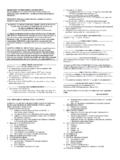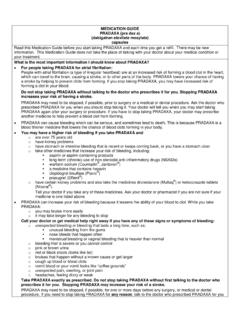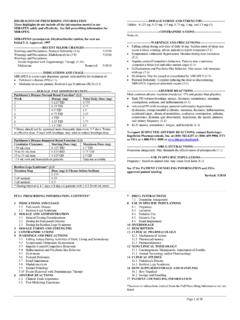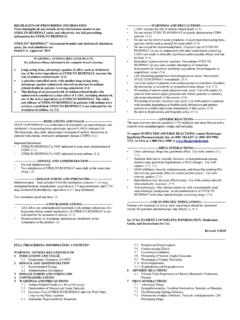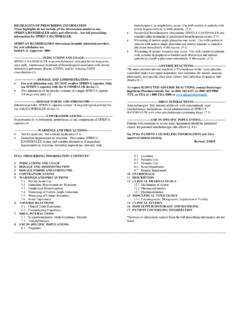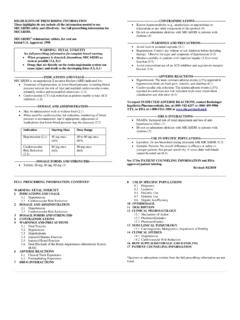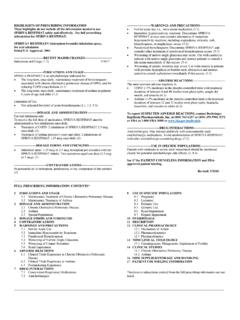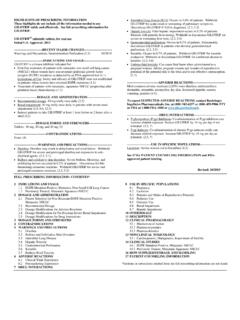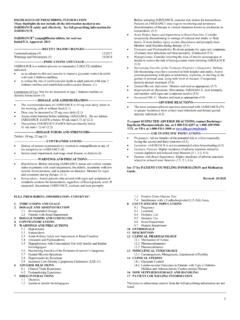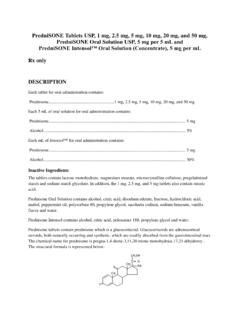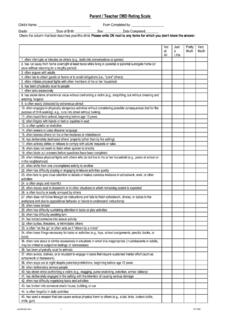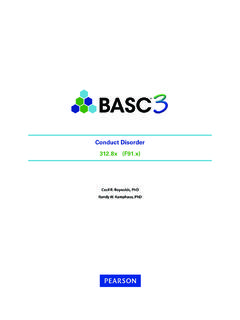Transcription of HIGHLIGHTS OF PRESCRIBING INFORMATION thereafter or as ...
1 1 HIGHLIGHTS OF PRESCRIBING INFORMATION These HIGHLIGHTS do not include all the INFORMATION needed to use OFEV safely and effectively. See full PRESCRIBING INFORMATION for OFEV. OFEV (nintedanib) capsules, for oral use Initial Approval: 2014 ---------------------------RECENT MAJOR CHANGES--------------------------- Dosage and Administration (2) 1/2018 Warnings and Precautions (5) 1/2018 ----------------------------INDICATIONS AND USAGE--------------------------- OFEV is a kinase inhibitor indicated for the treatment of idiopathic pulmonary fibrosis (IPF). (1) ----------------------DOSAGE AND ADMINISTRATION----------------------- Recommended dosage: 150 mg twice daily approximately 12 hours apart taken with food. ( ) Recommended dosage in patients with mild hepatic impairment (Child Pugh A): 100 mg twice daily approximately 12 hours apart taken with food.
2 ( , ) Consider temporary dose reduction to 100 mg, treatment interruption, or discontinuation for management of adverse reactions. ( , , , 6) Prior to treatment initiation, conduct liver function tests and a pregnancy test. ( , , ) ---------------------DOSAGE FORMS AND STRENGTHS---------------------- Capsules: 150 mg and 100 mg (3) -------------------------------CONTRAIND ICATIONS------------------------------ None (4) -----------------------WARNINGS AND PRECAUTIONS------------------------ Hepatic impairment: OFEV is not recommended for use in patients with moderate or severe hepatic impairment. In patients with mild hepatic impairment (Child Pugh A), the recommended dosage is 100 mg twice daily approximately 12 hours apart taken with food. Consider treatment interruption, or discontinuation for management of adverse reactions in these patients. ( , , , , ) Elevated liver enzymes and drug-induced liver injury: ALT, AST, and bilirubin elevations have occurred with OFEV, including cases of drug-induced liver injury.
3 In the postmarketing period, non-serious and serious cases of drug-induced liver injury, including severe liver injury with fatal outcome, have been reported. The majority of hepatic events occur within the first three months of treatment. Liver enzyme and bilirubin increases were reversible with dose modification or interruption in the majority of cases. Monitor ALT, AST, and bilirubin prior to initiation of treatment, at regular intervals during the first three months of treatment, and periodically thereafter or as clinically indicated. Temporary dosage reductions or discontinuations may be required. ( , , ) Gastrointestinal disorders: Diarrhea, nausea, and vomiting have occurred with OFEV. Treat patients at first signs with adequate hydration and antidiarrheal medicine ( , loperamide) or anti-emetics. Discontinue OFEV if severe diarrhea, nausea, or vomiting persists despite symptomatic treatment.
4 ( ) Embryo-Fetal toxicity: Can cause fetal harm. Advise females of reproductive potential of the potential risk to a fetus and to use effective contraception. ( , , ) Arterial thromboembolic events have been reported. Use caution when treating patients at higher cardiovascular risk including known coronary artery disease. ( ) Bleeding events have been reported. Use OFEV in patients with known bleeding risk only if anticipated benefit outweighs the potential risk. ( ) Gastrointestinal perforation has been reported. Use OFEV with caution when treating patients with recent abdominal surgery, previous history of diverticular disease or receiving concomitant corticosteroids or NSAIDs. Discontinue OFEV in patients who develop gastrointestinal perforation. Only use OFEV in patients with known risk of gastrointestinal perforation if the anticipated benefit outweighs the potential risk.
5 ( ) ------------------------------ADVERSE REACTIONS------------------------------- Most common adverse reactions ( 5%) are: diarrhea, nausea, abdominal pain, vomiting, liver enzyme elevation, decreased appetite, headache, weight decreased, and hypertension. ( ) To report SUSPECTED ADVERSE REACTIONS, contact Boehringer Ingelheim Pharmaceuticals, Inc. at (800) 542-6257 or (800) 459-9906 TTY or FDA at 1-800-FDA-1088 or -------------------------------DRUG INTERACTIONS---------------------------- -- Coadministration of P-gp and CYP3A4 inhibitors may increase nintedanib exposure. Monitor patients closely for tolerability of OFEV. ( ) -----------------------USE IN SPECIFIC POPULATIONS------------------------ Lactation: Breastfeeding is not recommended. ( ) Renal impairment: The safety and efficacy of OFEV have not been studied in patients with severe renal impairment and end-stage renal disease.
6 ( , ) Smokers: Decreased exposure has been noted in smokers which may alter the efficacy profile of OFEV. ( ) See 17 for PATIENT COUNSELING INFORMATION and FDA-approved patient labeling. Revised: 11/2018 _____ FULL PRESCRIBING INFORMATION : CONTENTS* 1 INDICATIONS AND USAGE 2 DOSAGE AND ADMINISTRATION Testing Prior to OFEV Administration Recommended Dosage Dosage Modification due to Adverse Reactions 3 DOSAGE FORMS AND STRENGTHS 4 CONTRAINDICATIONS 5 WARNINGS AND PRECAUTIONS Hepatic Impairment Elevated Liver Enzymes and Drug-Induced Liver Injury Gastrointestinal Disorders Embryo-Fetal Toxicity Arterial Thromboembolic Events Risk of Bleeding Gastrointestinal Perforation 6 ADVERSE REACTIONS Clinical Trials Experience Postmarketing Experience 7 DRUG INTERACTIONS P-glycoprotein (P-gp) and CYP3A4 Inhibitors and Inducers Anticoagulants Pirfenidone 8 USE IN SPECIFIC POPULATIONS Pregnancy Lactation Females and Males of Reproductive Potential Pediatric Use Geriatric Use Hepatic Impairment Renal Impairment Smokers 10 OVERDOSAGE 11 DESCRIPTION 12 CLINICAL PHARMACOLOGY Mechanism of Action Pharmacodynamics Pharmacokinetics 13 NONCLINICAL TOXICOLOGY Carcinogenesis, Mutagenesis, Impairment of Fertility 14 CLINICAL STUDIES 16 HOW SUPPLIED/STORAGE AND HANDLING 17 PATIENT COUNSELING INFORMATION *Sections or subsections omitted from the full PRESCRIBING INFORMATION are not 2 FULL PRESCRIBING INFORMATION 1 INDICATIONS AND USAGE OFEV is indicated for the treatment of idiopathic pulmonary fibrosis (IPF).
7 2 DOSAGE AND ADMINISTRATION Testing Prior to OFEV Administration conduct liver function tests and a pregnancy test prior to initiating treatment with OFEV [see Warnings and Precautions ( , )]. Recommended Dosage The recommended dosage of OFEV is 150 mg twice daily administered approximately 12 hours apart. OFEV capsules should be taken with food [see Clinical Pharmacology ( )] and swallowed whole with liquid. OFEV capsules should not be chewed or crushed because of a bitter taste. The effect of chewing or crushing of the capsule on the pharmacokinetics of nintedanib is not known. If a dose of OFEV is missed, the next dose should be taken at the next scheduled time. Advise the patient to not make up for a missed dose. Do not exceed the recommended maximum daily dosage of 300 mg. In patients with mild hepatic impairment (Child Pugh A), the recommended dosage of OFEV is 100 mg twice daily approximately 12 hours apart taken with food.
8 Dosage Modification due to Adverse Reactions In addition to symptomatic treatment, if applicable, the management of adverse reactions of OFEV may require dose reduction or temporary interruption until the specific adverse reaction resolves to levels that allow continuation of therapy. OFEV treatment may be resumed at the full dosage (150 mg twice daily), or at the reduced dosage (100 mg twice daily), which subsequently may be increased to the full dosage. If a patient does not tolerate 100 mg twice daily, discontinue treatment with OFEV [see Warnings and Precautions ( , , , ) and Adverse Reactions ( )]. Dose modifications or interruptions may be necessary for liver enzyme elevations. conduct liver function tests (aspartate aminotransferase (AST), alanine aminotransferase (ALT), and bilirubin) prior to initiation of treatment with OFEV, at regular intervals during the first three months of treatment, and periodically thereafter or as clinically indicated.
9 Measure liver tests promptly in patients who report symptoms that may indicate liver injury, including fatigue, anorexia, right upper abdominal discomfort, dark urine or jaundice. Discontinue OFEV in patients with AST or ALT greater than 3 times the upper limit of normal (ULN) with signs or symptoms of liver injury and for AST or ALT elevations greater than 5 times the upper limit of normal. For AST or ALT greater than 3 times to less than 5 times the ULN without signs of liver damage, interrupt treatment or reduce OFEV to 100 mg twice daily. Once liver enzymes have returned to baseline values, treatment with OFEV may be reintroduced at a reduced dosage (100 mg twice daily), which subsequently may be increased to the full dosage (150 mg twice daily) [see Warnings and Precautions ( ) and Adverse Reactions ( )]. In patients with mild hepatic impairment (Child Pugh A), consider treatment interruption, or discontinuation for management of adverse reactions.
10 3 3 DOSAGE FORMS AND STRENGTHS 150 mg capsules: brown, opaque, oblong, soft capsules imprinted in black with the Boehringer Ingelheim company symbol and "150". 100 mg capsules: peach, opaque, oblong, soft capsules imprinted in black with the Boehringer Ingelheim company symbol and "100". 4 CONTRAINDICATIONS None 5 WARNINGS AND PRECAUTIONS Hepatic Impairment Treatment with OFEV is not recommended in patients with moderate (Child Pugh B) or severe (Child Pugh C) hepatic impairment [see Use in Specific Populations ( ) and Clinical Pharmacology ( )]. Patients with mild hepatic impairment (Child Pugh A) can be treated with a reduced dose of OFEV [see Dosage and Administration ( )]. Elevated Liver Enzymes and Drug-Induced Liver Injury Cases of drug-induced liver injury (DILI) have been observed with OFEV treatment.
